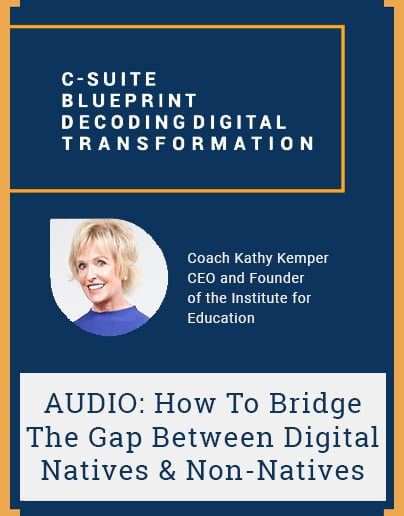C-Suite BluePrint: Decoding Digital Transformation
When you put a group of professionals together in a safe environment, each with a different specialty, you not only get a rich conversation but one that no one can monopolize.
Coach Kathy Kemper, CEO and Founder of the Institute for Education discusses creating safe environments to bring digital natives and non-natives together to facilitate value through conversations.
Join us as we discuss:
- Creating safe environments so relationships can form
- Releasing muscle memory in favor of more digitally professional habits
- Discussing Kathy’s professional journey
“Even now, I don’t think there’s a whole lot of real hardcore digital natives.” — Kathy Kemper
The Importance of Building Relationships
Building relationships must be part of your core skill set. You have to embrace people — talk to them, make time for them, care about them, and be interested in what they’re doing.
Kathy started the Institute for Education as she taught tennis to many “big shots.” One day, her husband said, “Kathy, you teach all these big shots tennis; why don’t we invite a couple of them to meet some of my colleagues?”
The first person to accept the invitation was Secretary of Defense Les Aspin. How do you get the Secretary of Defense to sit at your kitchen table and talk about life? If you’re Kathy, you coach him in tennis. The coaching led to a friendship because Kathy and Les enjoyed each other’s company. Friendships like these lead to professional relationships that grow into teams.
Whether you are a tennis coach or the CEO, you are part of a team.
“You put people together that know a lot about different things; it’s always going to be a good conversation.” — Kathy Kemper
Environments That Foster Relationships
The mission of the Institute for Education is to harness the power of data innovation and soft diplomacy in the global community. Soft diplomacy is critical because collaboration and partnerships are how people propel themselves, their employees, and their companies forward.
The Institute creates an environment that is safe and nonpartisan. It is where people can come together in nice settings, have a meal, and discuss whatever they’d like. People in the room may be leaders, major stakeholders, or seniors in their careers but not yet subject matter experts. It’s where those who want to learn, get educated, and rescale themselves can go.
Everyone feels comfortable, and that’s what matters.
Releasing Muscle Memory
Many organizations have strong muscle memory. That is, they’re stuck doing the same things in the same ways. That’s true even in companies where people want to grow and learn new things.
How do you release some of that muscle memory? How can you become a new type of athlete, so to speak, and change your behavior?
“If you’re not a digital native, you have to put in the time that it takes to learn as much as you can and be patient. And it is really not easy.” — Kathy Kemper
It’s a challenge. The smart way to approach organizational muscle memory is to think like a coach.
Say you’re an executive in the C-suite. You have to make sure people feel valued. For example, those who have been at the company for 25 or 30 years might not settle into new ideas as enthusiastically as a new hire. Ensure these long-time team members know how much you appreciate them and value their experience, so they don’t feel excluded from the process.
Kathy gave an example we can all relate to:
About eight years ago, the Institute for Education realized that kids from underrepresented student populations weren’t getting the access to laptops that other students were. Kathy and her team founded a free coding camp at the University of Southern California Viterbi School of Engineering, with all the tools in the building.
Students would come to campus, and then USC graduate students would coach them under the direction of a professor. It’s been a huge success; even kindergartners get exposure to a college campus. Some of the original campers have now graduated and are pursuing a degree in computer science.
The same thing happens in organizations. It takes a long time to see results from new initiatives, and all changes aren’t always large. However, change in the right environment can lead to organizational improvement over time.
Craving more? You can find this interview and many more by subscribing to C-Suite Blueprint on Apple Podcasts, on Spotify, or here.
Listening on a desktop & can’t see the links? Just search for C-Suite Blueprint in your favorite podcast player.
